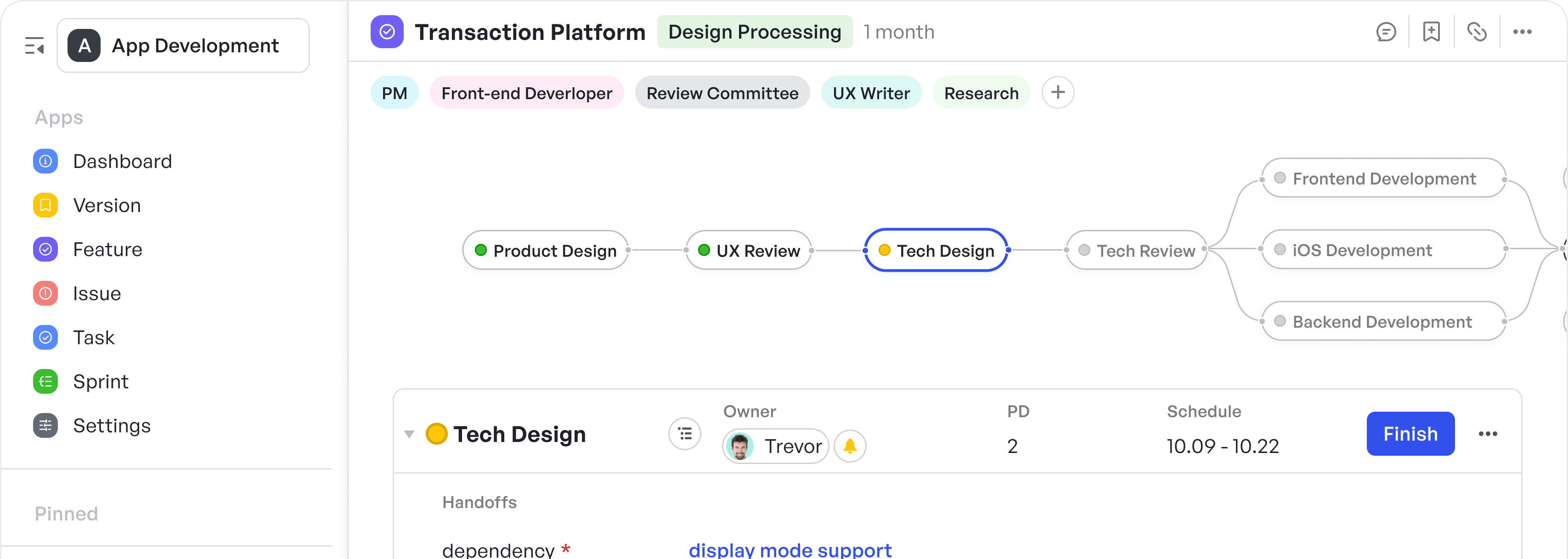Introduction
Project management is the cornerstone of any successful initiative, and the project management methodology employed is crucial in determining the project's overall flow and effectiveness. Two of the leading methodologies in the realm of project management are Waterfall and Agile. Each methodology offers unique features, benefits, and limitations. In this discussion, we'll compare the Waterfall and Agile project management methodologies, highlighting their primary attributes and exploring how they can be implemented within Meegle, a robust project management platform.
What is Waterfall Project Management?
Waterfall Project Management is a traditional project management methodology characterized by a linear, sequential approach to project delivery. This method is structured in such a way that each phase of the project life cycle must be completed before the next one begins, without any overlap between phases. It’s often contrasted with Agile project management, as part of the "waterfall vs agile project management" comparison, which allows for a more iterative, flexible approach to development.
The Waterfall model is divided into discrete phases, usually including requirements, design, implementation, testing, deployment, and maintenance. The project flows downwards through these stages like a waterfall, hence the name. This methodology thrives on its simplicity and clarity, with each phase having specific deliverables and a distinct review process. This clear structure makes Waterfall an excellent choice for projects with well-understood objectives and stable requirements.
250px|700px|reset
加载中,请稍后
One of the main features of Waterfall project management is its emphasis on documentation and upfront planning. Before any actual development begins, a thorough documentation of requirements and design is prepared, serving as a detailed roadmap for the project team. This extensive planning phase is crucial as once the project progresses beyond the initial stages, making changes becomes increasingly difficult and costly.
However, the Waterfall model’s rigidity is also seen as its primary limitation, especially when compared to Agile methodologies. Projects managed under Waterfall can struggle to adapt to changes in scope or requirements, leading to potential delays or increased costs if revisions are needed. This contrast in flexibility and adaptability forms the crux of the "waterfall vs agile project management" debate. Agile methods, with their iterative cycles and focus on customer feedback, can often better accommodate change and uncertainty.
Despite its challenges, Waterfall Project Management remains a viable and effective approach for certain types of projects. Projects with clear objectives, stable requirements, and a well-understood technology stack can benefit greatly from the predictability and order that Waterfall provides. It's particularly well-suited for projects in industries like construction and manufacturing, where the sequential execution of project phases is not only beneficial but often necessary.
Key Features of Waterfall Methodology:
Sequential Phases: The Waterfall model is characterized by a linear and sequential design where each phase must be completed before the next begins.
Thorough Documentation: This necessitates extensive documentation at each phase, making every detail of the project well-articulated.
Clear Milestones: With defined start and end points for each phase, progress is easily measurable.
No Overlapping Phases: Phases do not overlap in Waterfall; it’s a strict step-by-step approach.
Advantages:
Simplicity: The straightforward nature of Waterfall offers easy understanding and implementation, especially for new project managers.
Predictability: If the scope is clear and fixed, the Waterfall method can offer high levels of predictability regarding timelines and budgets.
Structured Design: Useful for industries that demand meticulous records, such as construction and manufacturing.
Disadvantages:
Inflexibility: Any changes in scope or requirements can lead to substantial delays and increased costs.
Late Testing: Issues may only become visible at the testing stage, which is often too late to make simple corrections.
What is Agile Project Management?
Agile Project Management is a flexible, iterative approach that emphasizes adaptability to change, contrasting sharply with the more rigid, sequential Waterfall model in the "agile project management vs waterfall" debate. Agile breaks projects into smaller, manageable iterations or sprints, allowing for continuous evaluation and adjustment at every stage. This methodology is ideal for environments where requirements and goals may shift, as it welcomes changes even late in the project lifecycle.
250px|700px|reset
加载中,请稍后
The core of Agile is its emphasis on collaboration, both within teams and with stakeholders. Regular feedback loops with customers ensure that the project aligns with their expectations, making Agile especially suitable for projects in fast-evolving fields like software development.
In essence, Agile offers a dynamic project management solution that prioritizes rapid adaptation, customer feedback, and quality outcomes. Its flexibility stands in contrast to Waterfall's structured planning, making it a better fit for projects where change is constant and unpredictability is expected.
Key Features:
Iterative Development: Agile promotes frequent reassessment and adaptation of plans.
Continuous Collaboration: It heavily involves stakeholders and clients, ensuring their feedback is incorporated.
Flexibility and Adaptability: Agile is designed to accommodate and even benefit from changes in project requirements.
Incremental Deliveries: Frequent releases with iterative testing ensure ongoing improvement and quick identification of issues.
Advantages:
Responsiveness to Change: Agile methodology is highly adaptable to changing project requirements which is vital in dynamic environments.
Customer Satisfaction: Continuous client engagement results in a higher level of customer satisfaction.
Risk Reduction: With earlier testing and reviews, risks are identified and mitigated early on.
Disadvantages:
Less Predictability: Due to its nature, projects can be less predictable in terms of deliverables and timelines.
Intensive Management: Agile requires an ongoing commitment from team members and stakeholders which can be resource-intensive.
Waterfall vs Agile: Key Differences
When it comes to project management methodologies, two of the most widely-discussed approaches are Waterfall and Agile. Understanding the core differences between Waterfall vs Agile is crucial for organizations to choose the methodology that best fits their project needs and team dynamics.
Project Timeline and Phases
Waterfall project management is linear and sequential, where each phase (conception, initiation, analysis, design, construction, testing, implementation, and maintenance) must be completed before the next begins. This approach can make project timelines more predictable but less flexible.
Agile, in contrast, is iterative and incremental. Projects are divided into small parts, known as sprints or iterations, allowing for ongoing evaluation and adaptation. This flexibility often leads to faster delivery times and the ability to adjust to changes more swiftly.
Flexibility and Adaptability
The Waterfall methodology is less flexible once a project phase has begun, as any changes require going back to the drawing board which can be time-consuming and costly.
Agile thrives on adaptability, permitting teams to respond to changes in client expectations or market trends quickly. This approach supports continuous improvement and allows projects to evolve based on feedback and testing throughout the development process.
Risk Management
In Waterfall projects, risks might not become apparent until the testing stage, which can lead to significant delays or cost overruns if issues need to be remediated.
Agile methodologies incorporate risk management into daily activities and encourage regular reassessment of risks, thus enabling issues to be identified and addressed much more promptly and often less expensively.
Stakeholder Involvement
Waterfall typically involves stakeholders during the requirements and final testing phases, which can sometimes lead to gaps between expectations and the finished product.
With Agile, stakeholder collaboration is a continuous process. Clients and stakeholders are involved throughout the project, providing feedback and adjustments to ensure the end product aligns closely with their needs.
Cost and Resource Planning
Waterfall requires extensive upfront planning and budgeting. Once the project is initiated, deviations from the plan can significantly impact costs.
Agile, with its emphasis on flexibility and iterative development, can potentially lead to more efficient use of resources. It allows organizations to reallocate budget and resources as the project evolves, which can result in cost savings and a more efficiently delivered project.
Understanding these key differences in "waterfall vs agile" methodologies assists organizations in selecting the most appropriate approach for managing their unique projects, balancing the need for predictability and flexibility according to their specific circumstances.
Pros and Cons of Waterfall Methodology
The Waterfall methodology, with its linear and sequential approach to project management, offers a clear structure but faces limitations in dynamic environments. Understanding its benefits and drawbacks can help determine its suitability for various project types.
Pros:
- Simplicity and Clarity: Waterfall's straightforward approach makes it easy to understand and manage. The project is divided into distinct phases, each with specific deliverables and review processes, which simplifies planning and execution.
- Defined Schedule and Budget: Given its reliance on thorough upfront planning, Waterfall allows for a relatively predictable schedule and budget. Each phase has defined goals and outcomes, facilitating better resource allocation and financial planning.
- Stable Requirements: Waterfall is most effective when project requirements are clear and unlikely to change. This stability allows teams to focus on meeting set objectives without the need to adapt to new information or shifting priorities.
- Comprehensive Documentation: The methodology emphasizes documentation at each phase. This detailed record-keeping aids in understanding project progression, making it easier for team members to stay informed and for new members to get up to speed.
Cons:
- Inflexibility to Change: Waterfall's biggest drawback is its rigidity. Once a phase is completed, revisiting or revising it if new information emerges or requirements change can be difficult and costly, potentially leading to outdated or irrelevant outcomes.
- Late Testing and Feedback: Testing occurs late in the project, which means any issues uncovered might require significant rework. Similarly, stakeholder feedback is often delayed, making it harder to incorporate changes that could enhance the final product.
- Risk of Overlooked Stakeholder Needs: Due to its sequential nature, there's a risk that the final product might not fully meet stakeholder or customer needs if those needs evolve or weren't fully understood at the project's outset.
Ideal Use Cases for Waterfall:
- Construction Projects: The linear progression suits construction well, where phases naturally build on one another, and changes in later stages can be enormously expensive.
- Manufacturing: Projects focused on mass production can benefit from Waterfall’s structured approach, especially when the product specifications are clear and unlikely to change.
- Software Development with Clear Requirements: Although Agile is often preferred for software projects, Waterfall can still be a good fit for software development with well-defined requirements and scope, particularly for projects where a detailed documentation is crucial.
In conclusion, while the Waterfall methodology presents clear benefits in terms of simplicity, predictability, and documentation, its inflexibility and late testing could pose significant risks in projects with variable scopes or those requiring frequent feedback. It remains well-suited for projects where requirements are stable and clearly defined from the start.
Pros and Cons of Agile Methodology
Agile Methodology is celebrated for its dynamic and flexible approach to project management, offering a contrast to the more rigid, linear Waterfall model. This adaptability sparks the "when to use agile vs waterfall" debate, emphasizing the necessity to choose a methodology based on project requirements, team dynamics, and stakeholder needs. Below are the strengths and weaknesses of Agile, providing insights into when it's best utilized.
Pros:
- Adaptability to Change: Agile allows for substantial flexibility, making it easier to adapt project specifications and directions based on evolving client needs and market trends.
- Enhanced Customer Satisfaction: Frequent iterations and continuous feedback loops with stakeholders ensure the end product more closely aligns with the customer's expectations and priorities.
- Early and Consistent Value Delivery: By delivering work in manageable chunks, Agile ensures that value is created and delivered consistently throughout the project, allowing for early detection of issues and adjustments.
- Increased Collaboration and Ownership: Agile encourages active participation and collaboration among team members, fostering a shared sense of ownership and responsibility towards the project's success.
Cons:
- Scope Creep: With the continuous evolution of project requirements, there's a risk of scope creep, potentially leading to extended deadlines and increased costs.
- Planning Challenges: Agile's iterative nature can make long-term planning more challenging, especially for budgeting and resource allocation.
- Requires High Engagement: The need for frequent meetings and close collaboration demands a high level of commitment and engagement from all team members, which might not always be feasible.
- Learning Curve: Teams new to Agile may experience a learning curve, as it requires a different mindset and approach compared to more traditional methodologies like Waterfall.
Example Projects Ideal for Agile:
- Software Development Projects: Agile is particularly well-suited for software development, where requirements can change quickly and the rapid delivery of new features is critical to staying competitive.
- Marketing Campaigns: The dynamic nature of marketing, with the need to adjust strategies based on market feedback, makes Agile an ideal choice.
- Product Development: Agile’s flexibility is advantageous in developing new products, allowing teams to iterate designs based on user feedback and market demands.
When to Use Waterfall vs Agile?
The decision of "when to use agile vs waterfall" hinges on various factors, including project scope, stakeholder needs, and the level of flexibility required. Both methodologies have unique strengths and cater to different project requirements and environments. Understanding detailed scenarios and examples where each method excels can help elucidate the best approach for a particular project.
When to Use Waterfall:
Waterfall is best suited for projects with well-defined requirements that are unlikely to change throughout the project. It offers a structured approach, making it ideal for projects where a clear path is visible from the beginning.
- Construction and Infrastructure Projects: These projects benefit from Waterfall's sequential phases. Changes late in the project can result in significant costs and delays, so the upfront planning and design phase is crucial.
- Regulatory and Compliance Projects: In industries where projects must adhere to strict regulatory standards and documentation is vital, Waterfall's comprehensive documentation process ensures all regulatory requirements are met.
- Projects with Fixed Budgets and Schedules: Waterfall's predictability in terms of budget and timeline makes it suitable for projects where these elements are fixed and non-negotiable.
When to Use Agile:
Agile is ideal for projects that operate in dynamic environments where requirements, scope, and solutions evolve through collaboration between self-organizing cross-functional teams. It focuses on customer feedback and quick iterations.
- Software Development: Agile allows for rapid development and testing of small increments of a software product, enabling teams to adapt to changing requirements or to pivot based on feedback from early releases.
- Innovative Product Development: For new products where market needs and technology may change rapidly, Agile facilitates quick adjustments as new information becomes available, ensuring the end product remains relevant.
- Projects Requiring Stakeholder Collaboration and Feedback: Agile thrives on stakeholder involvement, making it perfect for projects where ongoing collaboration and feedback are essential to define and refine the project’s outputs.
Choosing Between Agile and Waterfall:
Selecting the right methodology often involves assessing the level of uncertainty, the complexity of the project, and how much change you anticipate.
- Waterfall is beneficial when the project’s scope and requirements are clear from the start, and changes are unlikely or expensive to implement once the project has begun.
- Agile excels in environments that are unpredictable or where the project could benefit from iterative reviews and the flexibility to change course based on what the team learns during the project.
In essence, the choice of "when to use agile vs waterfall" depends on the specific circumstances and constraints of each project. Agile offers flexibility and adaptivity, which is valuable in rapidly changing environments, whereas Waterfall provides structure and predictability, ideal for projects with defined parameters and minimal change expected.
Combining Waterfall and Agile: Is a Hybrid Approach Possible?
Combining Waterfall and Agile methodologies into a hybrid approach is indeed possible and can offer the best of both worlds for certain projects. This hybrid, or "Agile-Waterfall" approach, leverages the structure and predictability of Waterfall for clear, well-defined project phases, and the flexibility and adaptability of Agile for phases where more iteration and stakeholder feedback are beneficial.
Cases where a Hybrid Approach Works:
- Large-Scale Enterprise Projects: Large projects may require the upfront planning and clear documentation of Waterfall for setting the project's scope and budget. However, within this framework, Agile can be utilized for developing individual components or features, allowing for iteration and adaptation based on stakeholder feedback.
- Product Development with Hardware and Software Components: In projects that involve both hardware (requiring rigorous planning and a sequential approach) and software (benefitting from iterative development), a hybrid approach can be effective. Waterfall can guide the hardware development, while Agile methodologies are applied to software development.
- Projects with Fixed Regulatory Milestones: Projects that must adhere to regulatory milestones or certifications can use Waterfall to ensure these fixed points are met. Agile can then be applied to the development work leading up to these milestones, maximizing flexibility and efficiency.
A hybrid approach allows teams to balance the need for thorough planning and documentation with the desire for agility and responsiveness. It is a testament to the idea that project management methodologies are not one-size-fits-all and can be tailored to the specific needs and constraints of a project.
How to Choose Between Agile and Waterfall for Your Project
Selecting the right project management methodology is crucial for the success of any project. The choice between Agile and Waterfall methodologies can impact project outcomes, team dynamics, and stakeholder satisfaction. To navigate this decision, consider several key factors that can guide you towards the methodology best suited to your project's unique needs and goals. Here's how to choose between Agile and Waterfall for your project:
- Assess Project Requirements: Start by understanding whether your project has clearly defined requirements or if they are likely to evolve. Use Waterfall for well-defined projects, and Agile for projects where requirements may change over time.
- Evaluate Project Timeline: If your project has a fixed timeline with a clear end date, Waterfall might be the best choice. If your project is more flexible with its timeline, Agile could allow for iterative progress and improvements.
- Determine Stakeholder Involvement: For projects with less frequent stakeholder involvement, Waterfall can be suitable. If stakeholders need continuous updates and feedback loops, Agile is better.
- Analyze Risk Management: Use Agile if your project requires regular risk assessments and adaptations. Waterfall is better for low-risk projects with predictable outcomes.
Select a Project Management Tool: Choose a project management tool like Meegle that supports both Agile and Waterfall methodologies. This flexibility will allow you to tailor your approach to the project's needs.
How Meegle Supports Both Waterfall and Agile Methodologies
Meegle is a project management tool designed to support various methodologies. Let's discuss how both Waterfall and Agile could be applied within this tool.
Waterfall on Meegle
In Meegle, a Waterfall approach can be structured using the task or project timelines. Meegle can support Waterfall’s need for comprehensive documentation by attaching files directly to tasks. Progress tracking can be visualized through Gantt charts and milestone tracking, ensuring everyone is aware of the project stage and deadlines.
Agile on Meegle
Agile's iterative cycles can be set up in Meegle using Sprints. The board feature allows the visualization of tasks in the form of Kanban, aligning with Agile's focus on progress and adaptability. Daily standups and sprint reviews can be scheduled within Meegle's calendar, enhancing team collaboration and communication.
250px|700px|reset
加载中,请稍后
Final Thoughts
Both Waterfall and Agile have their place in project management, depending largely on the project’s requirements, stakeholder expectations, and the surrounding environment. In choosing between them, consider factors like project complexity, need for flexibility, client involvement, and the team's working style.
Meegle supports both methodologies, offering project managers and teams the flexibility to work in the way they find most productive. By understanding these methodologies and their application to tools like Meegle, organizations can maximize their project success rates.
FAQs About Waterfall and Agile
- What is the difference between Agile and Waterfall project management?
The main difference lies in their approach to project execution. Waterfall follows a linear, sequential path where each phase must be completed before moving on to the next, making it ideal for projects with clear, unchanging requirements. Agile, on the other hand, adopts an iterative, flexible approach that allows for continuous feedback and changes throughout the project, better suited for projects with evolving requirements.
- Is Agile better than Waterfall?
Neither Agile nor Waterfall is universally "better" than the other; their effectiveness depends on the project's context. Agile is more adaptable and encourages frequent updates and stakeholder involvement, making it ideal for projects with uncertain or changing requirements. Waterfall offers a more structured and predictable framework, beneficial for projects with well-defined outcomes and timelines. The choice between Agile and Waterfall should be based on the specific needs and nature of the project.





